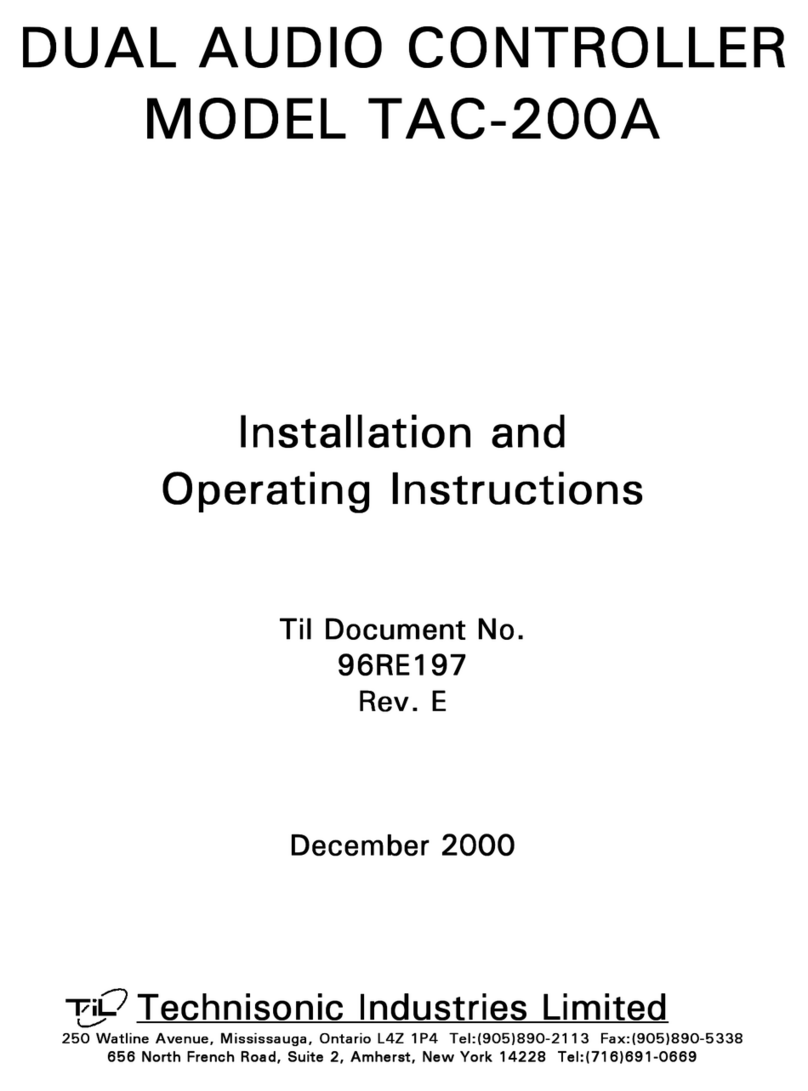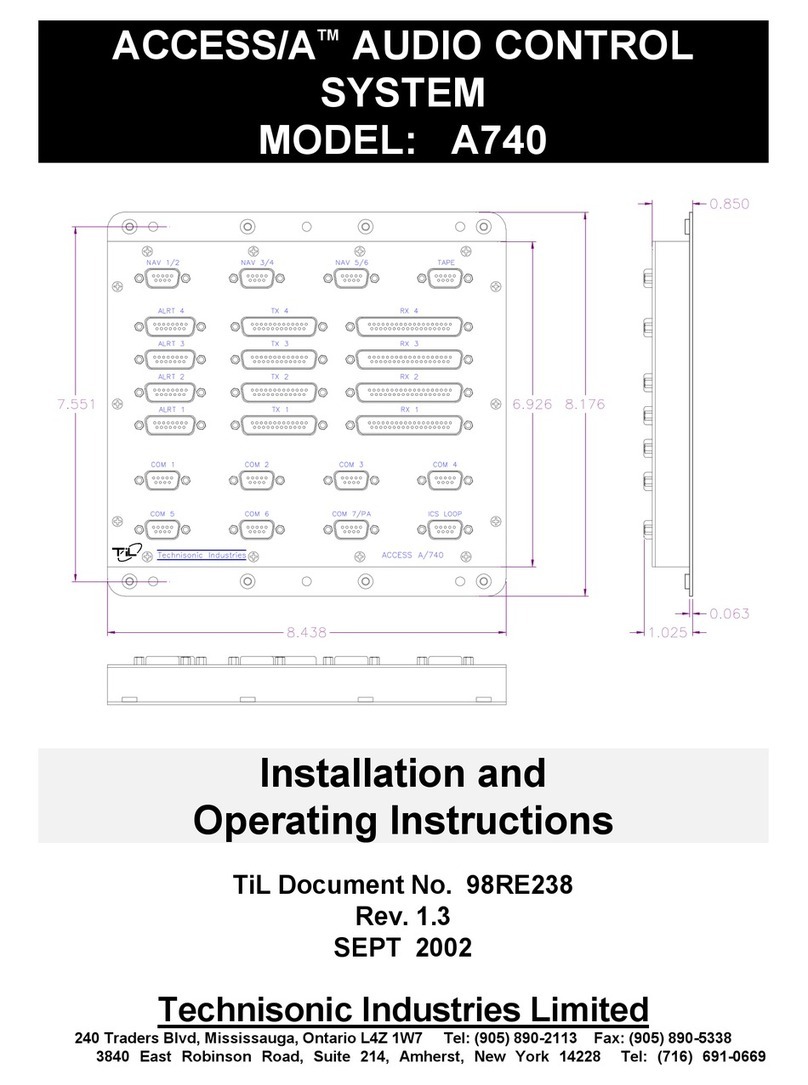Technisonic Industries Limited A710 User manual

ACCESS/A A710/A711
TSO’d High Performance Airborne Audio Systems
A710
A711
Technisonic High Performance Audio Control Stations
The ACCESS/A system is based on an integrated family of modular, field configurable, panel mounted controls,
coupled with external special function units, which produce a complete airborne communications suite. This flexible
audio system architecture supports extensive transceiver support, multiple ICS busses, alerting, warning and
signaling functions, voice message storage, partitioned crews, and greatly expanded interface capabilities.
ACCESS/A is the physical layer of interconnection and interface between airborne crews and their radio systems, as
well as providing internal intercom, internal and external paging, airframe alerting, music and entertainment
functions. ACCESS/A makes multiple independent crew groups with cross-linking easy to implement for applications
like emergency medevac or forestry aircraft, and delivers high performance solutions for the complex multi-
transceiver communications found in SAR, customs, emergency services and police aircraft.
Compare These Features
Unlike many existing systems, ACCESS/A A710 and A711 controls are designed to be continuously expanded,
relabeled and upgraded in the field, and can be easily re-configured as the aircraft systems are changed or
improved. Up to 10 crew stations, and up to 6 crew members per crew station can be supported within a single
aircraft. Many special modes and functions such as voice alerting, voice storage, NVG compatibility and custom
panel legends can be implemented to provide a very high level of completion center customization, and the modular
construction permits easy “one-shot” solutions for unusual mission specific problems.
Support for all common aircraft headset impedances is standard, including 8, 20, 150, 300 and 600 headsets, as is
“fail-passive” emergency headset and boom microphone operation. Carbon-equivalent, amplified dynamic and
amplified electret microphones are supported, and an optional external module can be installed for un-amplified low
impedance dynamic microphone support.
To address installation concerns and costs, ACCESS/A systems include A740 interconnect bays and modules that
reduce the labor, time and expense of configuring complex ship installations. A740 junction bays, to simplify wiring
and harness fabrication, packaged micro-speakers and user station jack & switch units are all available to solve
these problems quickly and inexpensively.
A710/A711 ACCESS/A stations support both speaker and headset based installations, and can provide internal
paging as well as interfaces to commercially available external paging systems.

General Specifications
Model A710/A711
Power requirements: Aircraft 28 VDC supply (-20% +15 %), 350 mA nominal load.
Meets TSO transient schedule, over voltage and brownout conditions.
28 Volt lighting @ 100 mA, 5 Volt lighting @ 340 mA.
Size and weight: A710 Dzus panel, (5.75” wide x 1.875” high x 6.07” deep). Weight 2.4 lbs.
A711 Dzus panel, (5.75” wide x 2.625” high x 6.07” deep). Weight 3.0 lbs.
Weights shown include optional alerting module.
Environmental: -40C/+70C operating, -55C/+85C survival temperature.
Humidity maximum 96% non condensing.
Shock 12g, any axis
Altitude, to 25,000 feet. (cat. B2)
DO-160C ENV. CAT. (A2B2)-CA(BMN)XXXXXXABBBAXZXXXXXX
Cosmetic: Panel color either Flat Black or Cessna Cadet Flat Gray.
Radio legends are field replaceable Lexan overlays.
System Features: One to six users per control station.
Direct push-button Tx function selection, no rotary switches.
A711 has individual transceiver volume controls, A710 does not.
Supports all headset impedance’s from 8 to 600 ohms.
Optional voice alerting functions with priority.
Optional voice message storage/replay function.
Six transceiver support, plus PA.
Headset and Speaker Outputs.
Soft music muting and stereo music input capability.
VOX, PTT or LIVE ICS modes
Individual Tx status enunciation.
High cross-talk and ground loop rejection.
Split ICS/Rx volume controls.
Emergency Rx/Tx capability, including boom mic support.
Changeable front panel legend system.
Long-life solid state panel lighting system, NVG option.
Configurable ICS loops.
Designed and TSO’d to RTCA C50c audio standard.
Supports multiple transmitter SIMULCAST operation.
Interface Data: At least 500 mW into 150 ohms (per primary user).
At least 1500 mW total into all users (150 ohms).
Distortion less than 2% THD at 1 kHz at total rated output.
Speaker output at least 2.5 Watts into 8 ohms.
Input to input isolation better than -70dB between radio inputs.
Deselected input isolation better than -65 dB.
Hum and noise better than -60dB below 500 mW.
Frequency response within 6dB from 300 Hz to 6000 Hz.
Up to 10 stations per system.
Floating input and output connections.
Ground seeking key and alert lines.
Note: Specifications are subject to change without notice
Technisonic Industries Ltd.
240 Traders Blvd, Mississauga, Ontario L4Z 1W7 CANADA
Ph: 905 890-2113 Fax: 905 890-5338 www.til.ca

Technisonic Industries Ltd. Printed in Canada Copyright 2009, All Rights Reserved
A710
Understanding ACCESS/A Audio
A711
3rd Generation Advanced Analog Systems
Technisonic Industries Ltd.
240 Traders Blvd.
Mississauga, ON Canada
L4Z 1W7
(905) 890-2113
(905) 890-5338
www.til.ca
Rev. 1.1 March, 2009
USERS: One ACCESS/A A710 or A711 station can support up to 6 headset positions in an aircraft, 2 flight
crew (pilot/co-pilot) with full transmit and ICS capability, and 4 passengers with radio monitor and ICS operation.
Passenger operation can also be extended to 5 or 6 positions if required, simply by adding resistors.
INTERCONNECT: Unlike earlier generation designs like the KMA24, AA95, and AMS40 series, the
interconnect in this system is FULLY FLOATING, which means that no audio lines use the airframe ground as
an audio return, thus avoiding noise, cross-talk and unwanted signal contamination. ACCESS/A systems offer as
much as 35dB of improvement in cross-talk (rejection of unwanted signals), a very important consideration in
multi-station systems. Up to 10 A71X-series stations can be used in a single network, and they can be configured
to have multiple ICS (Intercom System) loops.
POWER: Headset output level is a significant problem in many applications, as flight crews are now often
using inefficient helmets and earplugs. ACCESS/A systems offer the highest headset drive currently available in a
panel-mounted system, 1,500mW total. This is considerably more power than earlier generation systems of 100-
500mW. In addition, these systems also have a 2.5W speaker output for radio monitoring when headsets are off.
CUSTOMIZATION: Customization is always a problem in the audio world. Every ship seems to have
some custom issue that needs to be addressed in the audio system. ACCESS/A systems use an easily changed
backlit polycarbonate overlay inset that allows rapid customization of any panel without costly faceplate
changes. Systems already installed can be changed at any time, and custom new installations can be made
quickly with stock units and custom overlays. Faceplate lighting can be 28V or 5V, and NVG compatible lighting is
available. Extensive and convenient cosmetic options are available to the installer at very low cost.
SIMULCAST: Unlike rotary control audio systems, the pushbutton design and high powered mic driver of the
ACCESS/A A710 and A711 controls supports simulcast, allowing multiple radios to be used at once, often an
important operational requirement.
ALERTING: The ship’s audio system serves as the focal point for audible alerting signals passed to the
flight crew. Earlier generation system had limited connections for this, or a few tones that could be generated.
ACCESS/A systems have true voice alerting, with 6 spoken, prioritized messages, and the ability to record
and replay incoming audio. In addition, a direct headset alerting connection is also provided for existing shipboard
systems. Alert messages can also be recorded in any language on a custom basis.

Technisonic Industries Ltd. Printed in Canada Copyright 2009, All Rights Reserved
EXPANSION: ACCESS/A controls support 7 TX positions, which can be 6 radios and a PA, or 7
transceivers. Not enough? Need more inputs? Need more variable controls? The ACCESS/A architecture has
special sum node connections that allow inputs and transceivers to be expanded indefinitely either using
ACCESS/A system elements, or your custom external wiring.
A711X Transceiver expansion unit
A775 Receiver Expansion unit
ICS LOOP CONTROL: Often, a ship has to be broken into isolated intercom circuits, such as Medevac
applications, where the medical crew needs to work isolated from the flight crew. Using the ACCESS/A A770
eyebrow unit, additional receiver inputs, and full tie/split ICS loop control can be easily implemented. And in only 3
Dzus holes of panel space!
The A770 provides additional audio inputs,
ICS loop control with calling, and speaker
volume. Many custom variations are possible.
EMERGENCY OPERATION: One huge benefit of analog audio systems is their implicit ability to have
extensive “fail-passive” operation that permits radio operation even if there is serious internal failure, or power is
lost to the box. ACCESS/A systems allow the pilot to have full control of ALL transceivers, and continued cyclic
TX control even in this faulted condition or without power, a unique ACCESS/A feature. This mode can also be
used to provide an isolated radio-only mode for the pilot away from the rest of the users.
INTERCONNECT: Airframe interconnect is always time consuming and irritating, but ACCESS/A systems
can use the A740 interconnect patch bay to speed up harnessing, and provide for very clean cable fabrication
with convenient break and test points. All the connectors in the ACCESS/A system have fully mapped
interconnect that has logical pin assignments and easily followed connections.
The A740 provides a very easy way to manage complex
audio installations of up to 4 stations.

ACCESS/ATM AUDIO CONTROL
SYSTEM
MODELS: A710 & A711
Installation and
Operating Instructions
TiL Document No.
96RE189
Rev. 2.2
July 2009
Technisonic Industries Limited
240 Traders Blvd. E., Mississauga, Ontario L4Z 1W7 Tel:(905)890-2113 Fax:(905)890-5338
www.til.ca
Other manuals for A710
1
This manual suits for next models
1
Table of contents
Other Technisonic Industries Limited Recording Equipment manuals




















